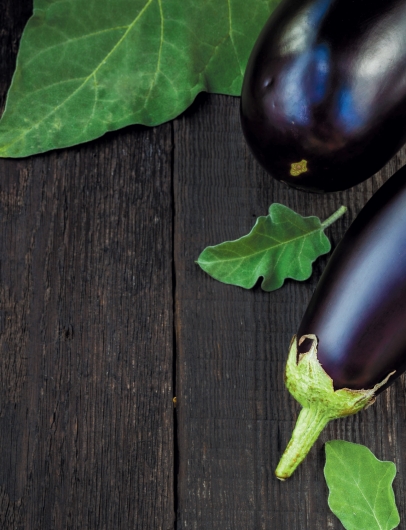In Season Summer
Here’s a list of the produce you can expect to find at your local farmers’ market and on local menus in the coming months. Ask where your food is grown and sourced.
Arugula • Basil • Blackberries • Blueberries • Butter Beans • Cantaloupe • Celery • Chanterelle Mushrooms • Chives • Corn • Cucumbers • Dill • Edamame • Eggplant • Field Peas • Figs • Fingerling Potatoes • Garlic • Ginger • Green Cabbage • Kale • Leeks • Melons • Micro Greens • Muscadines • Nectarines • New Potatoes • Okra • Onions • Peanuts • Peaches • Pears • Peas • Peppers • Potatoes • Raspberries • Scallions • Snap Beans • Squash + Zucchini • Strawberries • Swiss Chard • Tomatillos • Tomatoes • Watermelon
Indigenous to Asia where it is thought to have originated, eggplant, also called aubergine, has been enjoyed for more than 2,000 years. This versatile fruit, (yes, fruit) a cousin of tomato, bell pepper and potato—all part of the nightshade family—cohabitates beautifully in many dishes as an appetizer, sauce or the main meal. Eggplant can be steamed, fried, grilled, baked and stewed, and although it is edible raw, it doesn’t have a pleasing taste. It can be peeled or used with the skin left intact and absorbs oils and flavors wonderfully.
Black Magic, the deep, dark purple globe-shaped fruit, topped with a vibrant green blossom stem end, is the largest and most commonly found variety. Other more exotic fruits including Japanese, variegated and miniatures are easily accessible at farmers’ markets and just as easily grown in home gardens. These varieties come in an assortment of colors including white, green, yellow-orange and even black. And as different as they all look, their taste is very similar. The main difference among varieties is the texture, ranging from firm to creamy.
Choose eggplants that are firm to the touch and have smooth, shiny skin with no shriveling or soft spots. Also check the calyx (the green leaves at the stem end): It should be fresh and green, not dried out and brown.
The best way to store eggplant is at room temperature but use within a day or two. They can be refrigerated, but not for too long as they will begin to deteriorate.
According to the Academy of Nutrition and Dietetics, eggplant is considered a functional food—a food that potentially has beneficial effects on health when consumed as part of a varied diet at effective levels.
Eggplant is a high-fiber, low-calorie food. Although not high in any one nutrient, eggplant contains a variety of vitamins, minerals and antioxidants, believed to have positive health benefits.









